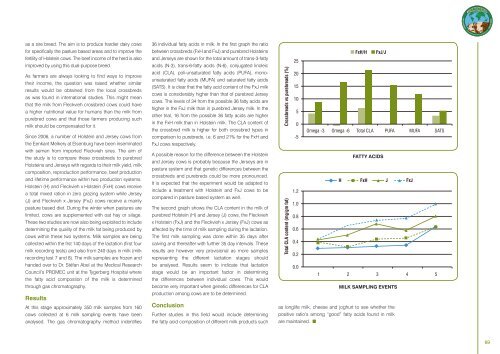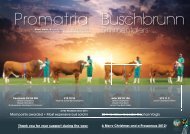Simmentaler Joernaal 2013.indb
Simmentaler Joernaal 2013.indb
Simmentaler Joernaal 2013.indb
You also want an ePaper? Increase the reach of your titles
YUMPU automatically turns print PDFs into web optimized ePapers that Google loves.
as a sire breed. The aim is to produce hardier dairy cows<br />
for specifically the pasture based areas and to improve the<br />
fertility of Holstein cows. The beef income of the herd is also<br />
improved by using this dual-purpose breed.<br />
As farmers are always looking to find ways to improve<br />
their income, the question was raised whether similar<br />
results would be obtained from the local crossbreds<br />
as was found in international studies. This might mean<br />
that the milk from Fleckvieh crossbred cows could have<br />
a higher nutritional value for humans than the milk from<br />
purebred cows and that those farmers producing such<br />
milk should be compensated for it.<br />
Since 2006, a number of Holstein and Jersey cows from<br />
the Eenkant Melkery at Elsenburg have been inseminated<br />
with semen from imported Fleckvieh sires. The aim of<br />
the study is to compare these crossbreds to purebred<br />
Holsteins and Jerseys with regards to their milk yield, milk<br />
composition, reproduction performance, beef production<br />
and lifetime performance within two production systems.<br />
Holstein (H) and Fleckvieh x Holstein (FxH) cows receive<br />
a total mixed ration in zero grazing system while Jersey<br />
(J) and Fleckvieh x Jersey (FxJ) cows receive a mainly<br />
pasture based diet. During the winter when pastures are<br />
limited, cows are supplemented with oat hay or silage.<br />
These two studies are now also being exploited to include<br />
determining the quality of the milk fat being produced by<br />
cows within these two systems. Milk samples are being<br />
collected within the frst 140 days of the lactation (first four<br />
milk recording tests) and also from 240 days in milk (milk<br />
recording test 7 and 8). The milk samples are frozen and<br />
handed over to Dr. Stéfan Abel at the Medical Research<br />
Council’s PROMEC unit at the Tygerberg Hospital where<br />
the fatty acid compostion of the milk is determined<br />
through gas chromatography.<br />
Results<br />
At this stage approximately 350 milk samples from 160<br />
cows collected at 6 milk sampling events have been<br />
analysed. The gas chromatography method indentifies<br />
36 individual fatty acids in milk. In the first graph the ratio<br />
between crossbreds (FxH and FxJ) and purebred Holsteins<br />
and Jerseys are shown for the total amount of trans-3-fatty<br />
acids (N-3), trans-6-fatty acids (N-6), conjugated linoleic<br />
acid (CLA), poli-unsaturated fatty acids (PUFA), monounsaturated<br />
fatty acids (MUFA) and saturated fatty acids<br />
(SATS). It is clear that the fatty acid content of the FxJ milk<br />
cows is considerably higher than that of purebred Jersey<br />
cows. The levels of 34 from the possible 36 fatty acids are<br />
higher in the FxJ milk than in purebred Jersey milk. In the<br />
other trial, 16 from the possible 36 fatty acids are higher<br />
in the FxH milk than in Holstein milk. The CLA content of<br />
the crossbred milk is higher for both crossbred types in<br />
comparison to purebreds, i.e. 6 and 21% for the FxH and<br />
FxJ cows respectively.<br />
A possible reason for the difference between the Holstein<br />
and Jersey cows is probably because the Jerseys are in<br />
pasture system and that genetic differences between the<br />
crossbreds and purebreds could be more pronounced.<br />
It is expected that the experiment would be adapted to<br />
include a treatment with Holstein and FxJ cows to be<br />
compared in pasture based system as well.<br />
The second graph shows the CLA content in the milk of<br />
purebred Holstein (H) and Jersey (J) cows, the Fleckvieh<br />
x Holstein (FxJ) and the Fleckvieh x Jersey (FxJ) cows as<br />
affected by the time of milk sampling during the lactation.<br />
The first milk sampling was done within 35 days after<br />
calving and thereafter with further 35 day intervals. These<br />
results are however very provisional as more samples<br />
representing the different lactation stages should<br />
be analysed. Results seem to indicate that lactation<br />
stage would be an important factor in determining<br />
the differences between individual cows. This would<br />
become very important when genetic differences for CLA<br />
production among cows are to be determined.<br />
Conclusion<br />
Further studies in this field would include determining<br />
the fatty acid composition of different milk products such<br />
FATTY ACIDS<br />
MILK SAMPLING EVENTS<br />
as longlife milk, cheese and joghurt to see whether the<br />
positive ratio’s among “good” fatty acids found in milk<br />
are maintained.<br />
69



